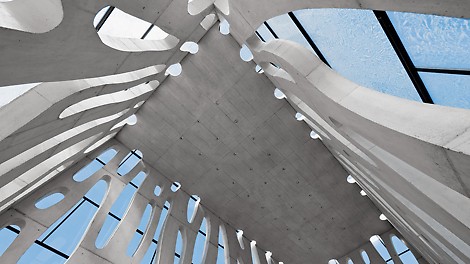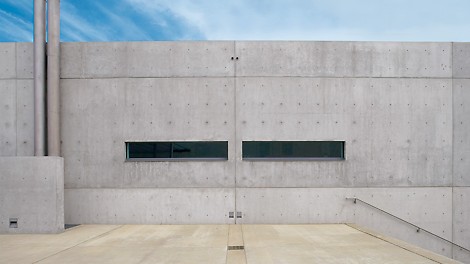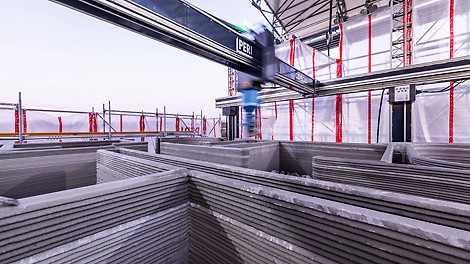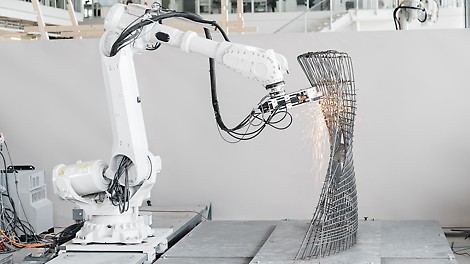Further project examples
Discover more interesting projects

The tie and joint pattern is often used for the design of exposed concrete projects. The formwork used plays an important role in this. For framed formwork, tie patterns and the frame imprint in the concrete are predefined. With the centrally arranged tie points, the result is a regular joint pattern – both horizontally and vertically. With the possibility of combining different element sizes, PERI also offers the option of flexibly designing the concrete surfaces. As a rule, framed formwork achieves exposed concrete results from SB 1 to SB 2. With PERI MAXIMO, the production of exposed concrete class SB 3 is also possible following consultation with the client.
Girder formwork offers universal design options without a frame imprint in the concrete appearance. While prefabricated standard sections have fixed element sizes according to the specifications, object-related formwork sections are more flexible. The formlining (type, size, fastening), girder and ledger position (spacing) as well as the tie pattern can be freely selected in compliance with the system principles. Depending on the system, exposed concrete results from SB 3 to SB 4 are achieved.
With the PERI Library+, architects have the possibility to integrate the suitable formwork solution into a Revit model already during the planning phase in order to visualise the final concrete appearance in advance.
Below you will find a selection of projects in which tie patterns and joint patterns were used as architectural design elements.
Discover more interesting projects
A very effective design element of exposed concrete walls are the tie holes. These can either remain open or be closed. Fibre concrete or poured concrete cones or plugs are suitable for closure. Depending on whether the closure is flush with the wall element or offset to the rear, the result is a flush closure or a shadow joint.
The pattern of the formwork ties depends on the system used and can only be influenced to a limited extent, for example by so-called blind ties. They supplement the tie points required for the formwork. This creates an even and orderly tie pattern.
Find even more information in our practical handbook Formwork Technology Architectoral Concrete
Unusual geometries, sharp edges or curved surfaces are the distinguishing features of many buildings. For their realisation, specially made free-form formwork is usually required.
PERI engineers plan these architecture-specific formwork bodies based on a 3D model. For a precise arrangement of the later visible joint and tie grid they always also consider the formwork assembly on the construction site. In the factory, the 3D solids are pre-assembled with millimetre precision, so that they can be assembled easily on the construction site. The wide range of international project experiences of PERI have led to a high degree of detailing and standardisation in the sequence of such formwork projects. As a result, for example, larger elements, improved element connections as well as higher concrete pressures and concreting heights than normally are possible. At the same time, concrete surfaces of the highest visible quality are achieved without visible imprints in the concrete.
Curved walls can also be constructed with PERI systems: Through polygonal approximations to the desired geometry with the help of panel formwork or with custom-made girder formwork. Circular wall areas with bending radii from 1.00 m to about 20.00 m can be realised steplessly.
Find even more information in our PERI report Aquatics Centre, London.
3D printers offer numerous new architectural design possibilities that can be implemented quickly and inexpensively.and inexpensively. From individual shapes to special surfaces and colours, almost anything can be realised. PERI developed the technology into a full-scale construction process in 2020, ensuring the first 3D-printed houses that are regularly rented and occupied.
Learn more about 3D construction printing
MESH technology is a form of robot-assisted technology for efficient and cost-effective production of complex reinforced concrete components, which does not require any formwork.
The main idea is to use an automated prefabrication process to produce complex or curved reinforcement cages, which would normally have been produced by hand using elaborate conventional formwork methods. The 3D reinforcement elements created in this way serve as formwork and reinforcement in equal measure and are filled with a specific concrete mixture.
MESH technology combines digital planning with robot-assisted fabrication to enable quick and easy production of the 3D reinforcement elements. These can be used both for formwork and reinforcement purposes. (Photo: MESH AG)
MESH technology enables cost-efficient production of complex geometries in addition to offering a completely new level of design freedom in terms of shape and surface structure. (Photo: MESH AG)
You can find even more information about the innovative technology on the MESH website.
Do you need support in planning special formwork solutions or advice from our specialist engineers? Then contact our PERI experts in your country.
Discover more interesting projects











